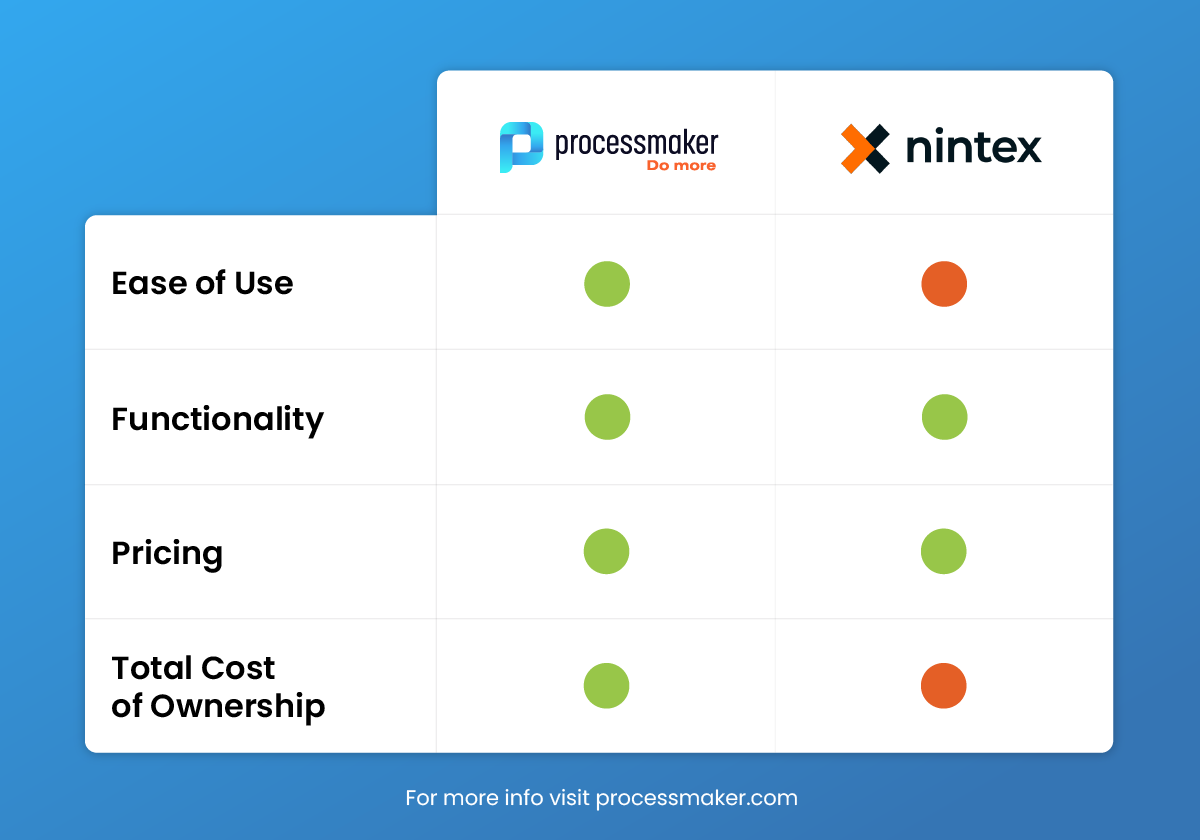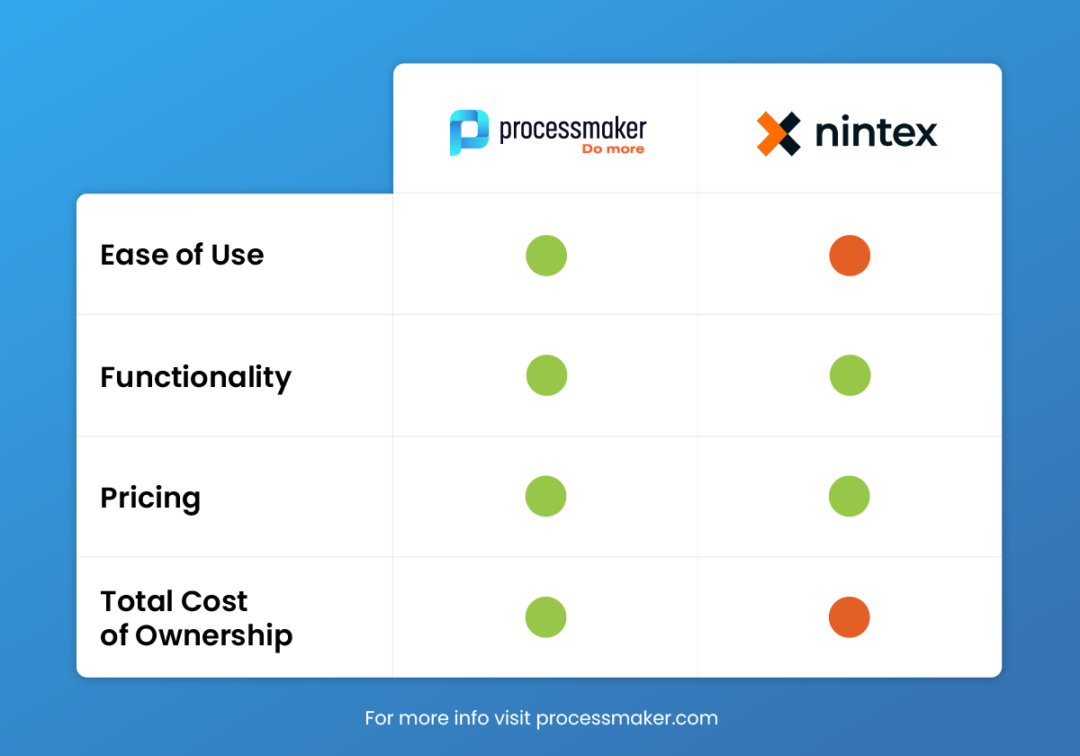Comparing ProcessMaker & Nintex
Blog: ProcessMaker Blog
In today’s fast-paced business environment, companies constantly seek new ways to streamline operations, improve efficiency, and boost productivity. Because let’s face it, we all want to spend less time on monotonous clerical tasks and more time on high-priority projects. So what’s the best strategy for managing these processes? Workflow and Business Process Management (BPM) solutions have emerged as a key technology in this effort, helping organizations like yours automate and optimize their processes. Two of the leading problem solvers in this field are ProcessMaker and Nintex, but which one fits your company’s specific needs? Let’s compare the two solutions to help you determine which one best suits your organization.
ProcessMaker vs. Nintex: A quick overview
BPM is an ideology revolving around managing and optimizing business processes. It involves analyzing and improving business processes to effectively achieve organizational goals and objectives. BPM encompasses a range of activities, including process design, execution, monitoring, and analysis. BPA, or business process automation, is the software that will realize all these ideas by eliminating up to 90% of manual tasks, automating your repetitive tasks, business processes, and securing your organizational success.
Like BPA, workflow automation refers to using software tools to automate tasks, actions, or activities involved in a business process. These tools are designed to eliminate repetitive and manual tasks, allowing businesses to streamline their processes for greater efficiency and accuracy. While similar to BPA, the focus and scope of workflow automation is smaller.
Using all of these aforementioned qualities, BPM and workflow automation often work hand-in-hand, offering an effective solution to your business’ problems. But that doesn’t mean all of these platforms operate the same way.
ProcessMaker
Let’s start with ProcessMaker, a cloud-based workflow and BPM solution designed for the enterprise. ProcessMaker provides a user-friendly drag-and-drop interface for creating custom workflows and includes features such as case management, form builder, and reporting. ProcessMaker also connects and integrates with your main applications, existing legacy systems, and point solutions. In addition to these benefits, ProcessMaker also offers mobile access and real-time collaboration, making it easy to access workflows and track progress from anywhere, at any time.
Nintex
Another option is Nintex. The platform operates as a workflow and BPM solution to offer a range of features for automating and optimizing business processes. Nintex also provides a drag-and-drop interface for creating custom workflows and features such as form builder, document management, and mobile access. Additionally, Nintex has a range of integrations with Microsoft-based business tools and platforms, making it easy to integrate into existing workflows and systems.
ProcessMaker vs. Nintex: Ease of Use
Now that we’ve tackled the basics of each platform, let’s explore some pros and cons, starting with ease of use. Not everyone is tech-savvy, so offering an interface primed for user experience is crucial. ProcessMaker and Nintex offer user-friendly, low-code drag-and-drop interfaces for creating custom workflows. Despite being similar in these facets, the two platforms differ regarding accessibility.
While all platforms have a learning curve, some users may find Nintex’s interface more complex and less intuitive than ProcessMaker, making its learning curve steeper than others. In contrast, automating workflows with ProcessMaker is simpler, even for users with less technical aptitude.
ProcessMaker vs. Nintex: Functionality
Both ProcessMaker and Nintex offer a range of features for automating and optimizing business processes, including case management, form builder, and reporting. The two platforms provide additional features like document management and various integrations with popular business tools and platforms.
To set the two apart, Nintex leverages RPA, while ProcessMaker offers an intelligent document processing (IDP) solution on top of its platform, making it a more comprehensive solution for organizations looking to automate a broader range of processes. On the other hand, RPA is excellent for structured, concisely worded documents, making it a prime option for sorting through spreadsheets, bank statements, and receipts.
In contrast to RPA, IDP is better suited for combing through unstructured documents that don’t adhere to a standardized organization, like PDFs, texts, emails, etc. This ProcessMaker function makes it much easier to analyze and manage your data, as IDP will organize the complex information you feed it. So though Nintex provides various tools for automating processes, it may not be the best choice for organizations that need more advanced automation capabilities. More complex workflows would require extensive technical resources in a platform such as Nintex to automate when compared to the low-code ProcessMaker platform.
ProcessMaker vs. Nintex: Pricing/Total Cost of Ownership
When it comes to choosing a platform, affordability is key. We all know that cost is one of the most crucial factors for a company choosing software. Your organization, like all others, has a budget, and while some software will be well within your range, others might be completely outside of it. Affordability is important, so there’s no point in ignoring the topic.
Regarding pricing, both ProcessMaker and Nintex offer flexible pricing tiers that can accommodate organizations of all sizes.
Nintex splits its offering into seven products, each with its own pricing. ProcessMaker is known for being cost-effective, especially since it’s an open-source platform that allows businesses to customize it to their needs. But regardless of these pricing similarities, the cost of both tools may vary based on the specific features and integrations required by your organization.
It’s best to focus on the features you need before comparing costs for which platform better fits your organization’s budget. The technical resources required to automate complex processes vary between the two platforms with ProcessMaker offering a much lower barrier to entry. And though Nintex’s starting prices may be lower, adding complex integrations will gradually increase your cost of ownership over time.
Which is right for you?
ProcessMaker and Nintex are innovative leading workflow and BPM solutions that can help your organization streamline operations, improve efficiency, and boost productivity. Both of these solutions offer user-friendly drag-and-drop interfaces for creating custom workflows and case management, forms builder, and reporting features. And while they may differ in some areas of cost and functionality, both platforms are excellent options for business process management and workflow automation. Both tools are designed to streamline your operations for improved efficiency and success.
To summarize: Nintex may be a better fit for companies that need help sorting through structured documents to streamline monotonous tasks. The platform offers a user-friendly interface with robust functionality. The downsides of the platform are that there’s a steep learning curve, and it isn’t as intuitive if you need to comb through unstructured documents. You also may not need all the resources available to you.
ProcessMaker is a cost-effective, customizable platform that’s easy to use without being tech-savvy and is prepared to handle complex tasks. But if you’re focused on automating simple processes, using ProcessMaker might be more than you need.
With this being said, ProcessMaker’s additional functionality and integrations may make it a better fit for a range of businesses and industries with more complex needs. There’s no one-size-fits-all BPA solution, so the best solution will ultimately depend on your organization’s specific needs and requirements.
Ready to boost productivity and streamline tasks?
The post Comparing ProcessMaker & Nintex appeared first on ProcessMaker.
Leave a Comment
You must be logged in to post a comment.








